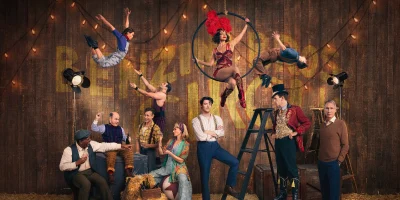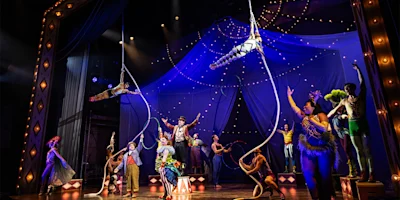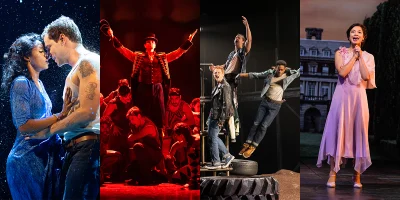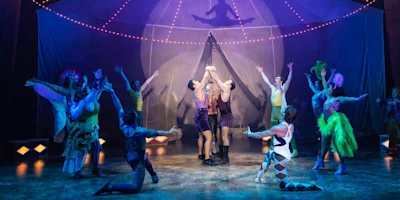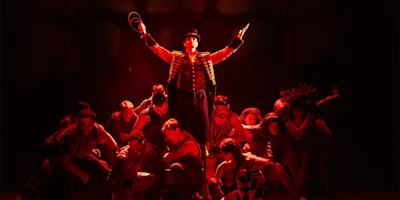
How 'Water for Elephants' brings the circus to Broadway
The show's cast and creative team use circus performances not only to amaze audiences, but creatively depict the characters' various memories and emotions.
The Imperial Theatre doesn't look like your usual big top, but thanks to a rustic sign that reads "On the other side of this wall is the greatest show on Broadway," the passersby on Eighth Avenue can have no doubt a circus is there. But Water for Elephants, the new musical adaptation of Sara Gruen's novel, doesn't look like your usual circus, either.
It's a unique hybrid unlike anything else on Broadway right now: You get to see circus and theatre all in one. The show takes place largely among the players of a 1930s traveling show, with whom Jacob Jankowski (Grant Gustin), a vet school dropout seeking a fresh start, stows away. His time with them — during which he becomes an animal handler, falls for the ringmaster's wife, Marlena, and witnesses one of the most infamous (fictional) disasters in circus history — unfolds from the perspective of an elderly Jacob (Gregg Edelman) sharing his story.
The Act 1 finale alone includes a variety of circus acts including clowning (performed by actor Joe De Paul, who was an actual circus clown for 25 years), ladder balancing, aerialists, and the first reveal of Rosie the elephant, the star among a glitter-dusted menagerie of stylized animal puppets.
But that's the only reenactment of a literal circus show in Water for Elephants. The rest of the circus acts function like the song and dance: as artistic representations of all sorts of scenarios.
"Jacob Jankowski spent a critical part of his life in circus," said Shana Carroll, the show's circus designer and co-choreographer. "Memory is altered as you get older, and he's seeing his past through the language of circus."
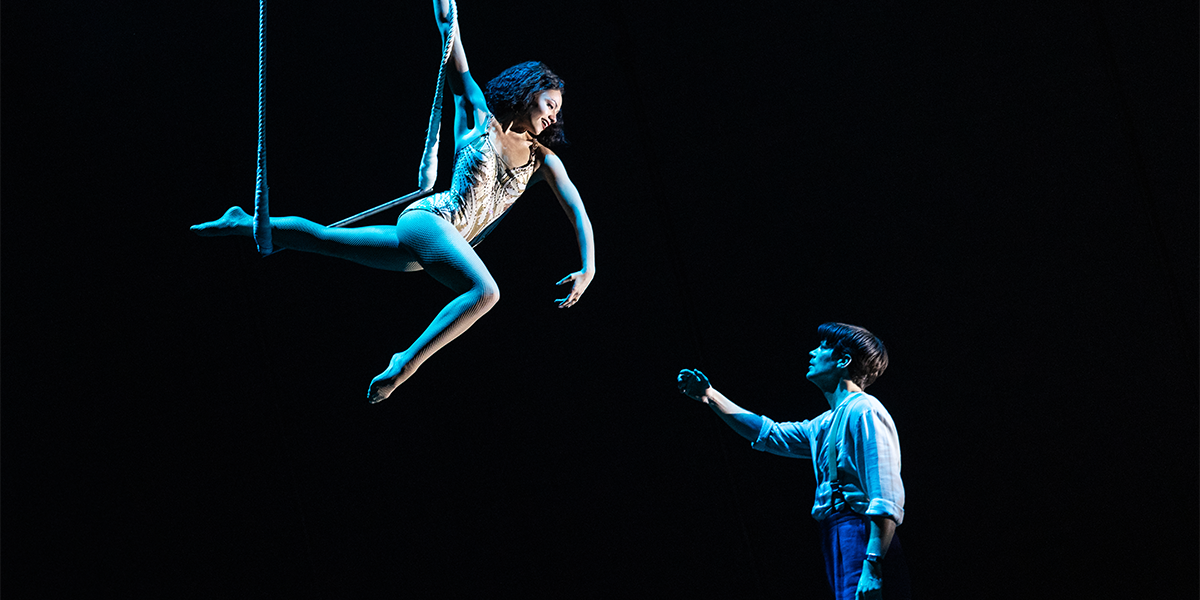
Take an Act 1 scene in which the ensemble sets up the circus tent. One man floats above the crowd, hanging steadily from the pole that holds up the big top — and then plummets down it headfirst, catching himself a jaw-dropping few inches from the ground.
In a later dream sequence, in which a young Jacob reflects on his tragedy-ridden past and uncertain future with Marlena, various circus acts represent his inner turmoil. Instead of the proverbial gears spinning in his head, it’s hoop dancers and an angelic Marlena (Isabelle McCalla) on a trapeze.
To authentically integrate circus into the show throughout, Water for Elephants employed Carroll and choreographer Jesse Robb, who have a combined 20+ years of circus experience. Through Jacob's eyes, they provide behind-the-scenes glimpses of the circus that audiences don't usually get. Carroll said raising the tent, for example, is regarded as "a show in and of itself" in the circus world.
Equally important for her team to convey, and reflected on stage and off, is the unique camaraderie among circus performers. Carroll and Robb, together with director Jessica Stone, assembled an ensemble of performers with various backgrounds — singing, dancing, acting, and circus, including Cirque du Soleil — so they could all learn from each other.
"It would be easy to have the singers sing and the acrobats do back handsprings and the actors memorize their scenes, but we have acrobats who sing and singers who dangle from trapezes and actors who are doing puppeteering," Carroll said. Robb described the process as "a kind of [game of] telephone," with movements changing ever so slightly as each new person embodies them.
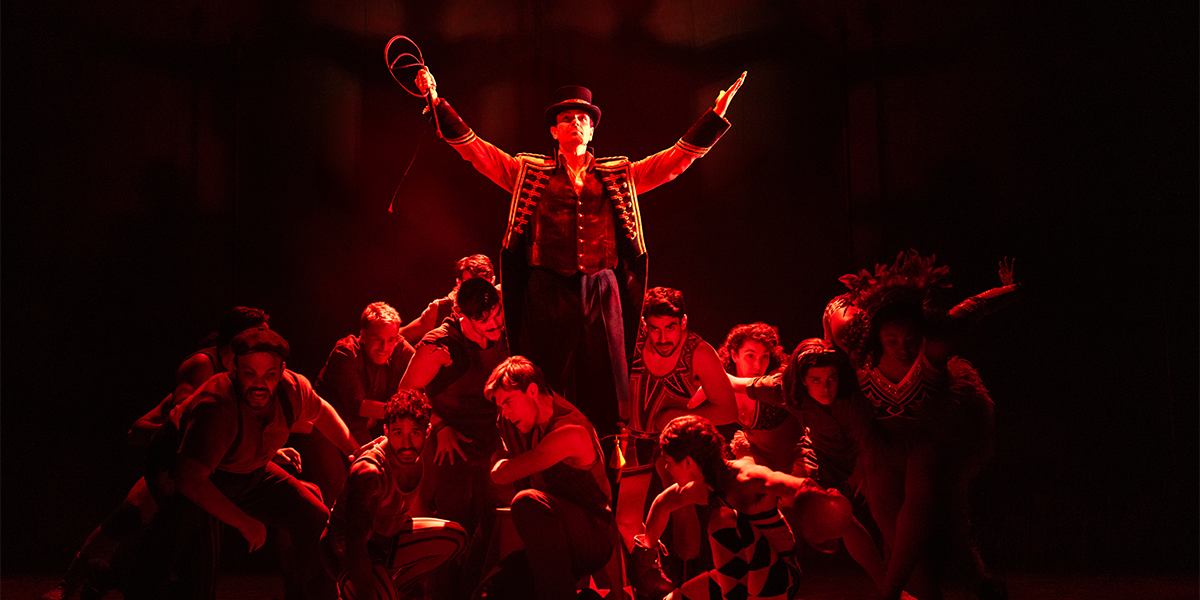
Because everyone is stepping out of their comfort zone, they all must trust each other, just like in the real circus. "I was a showgirl for many years in my 20s," said actor Sara Gettelfinger, who plays showgirl Barbara in Water for Elephants. "The difference is when you are in the community of a circus, whether you are flying through the air or climbing or swinging from fabric or a ring, everyone must be aware."
"Circus is the most apt form to show our interdependence," Carroll echoed. When someone is doing a trick, "every person is needed for that person to stay alive."
That idea mirrors a major theme of Water for Elephants: how the circus, and the family Jacob finds within it, saves him from despair. The circus acts aren't just there to amaze, but when they do anyway, they deepen the plot, too. The audience experiences the thrill of the circus as Jacob once did — that's how he remembers it, and he's sharing that excitement with us. He couldn't tell us his story without it.
"It's not just that they're interwoven," Gettelfinger said of the circus acts. "They are necessary."
Photo credit: Water for Elephants on Broadway. (Photos by Matthew Murphy)
Frequently asked questions
What is Water For Elephants about?
Sara Gruen's bestselling novel is now a high-flying musical-meets-circus spectacular. After tragedy strikes, Jacob quits vet school and stows away with a traveling circus — and ends up in a secret love affair with the ringmaster's wife that causes tension under the big top.
Where is Water For Elephants playing?
Water For Elephants is playing at Imperial Theatre. The theatre is located at 249 West 45th Street (between Broadway and 8th Avenue), New York, 10036.
How long is Water For Elephants?
The running time of Water For Elephants is 2hr 40min. Incl. 15min intermission.
What's the age requirement for Water For Elephants?
The recommended age for Water For Elephants is Ages 8+. Children under 4 are not permitted in the theater..
How do you book tickets for Water For Elephants?
Book tickets for Water For Elephants on New York Theatre Guide.
Who wrote Water For Elephants?
Rick Elice wrote the book for the Water for Elephants musical, based on Sara Gruen's original novel. He’s known for his Tony-nominated writing on Jersey Boys and Peter and the Starcatcher. The musical collective PigPen Theatre Co. wrote the songs.
Who directed Water For Elephants?
Jessica Stone directs Water For Elephants. She was nominated for a Tony Award for directing Kimberly Akimbo in 2023.
What are the songs in Water For Elephants?
PigPen Theatre Co. wrote the original music and lyrics for this show. The songs include “The Lion Has Got No Teeth,” “Just Our Luck,” and “Squeaky Wheel.”
Is Water For Elephants appropriate for kids?
Water For Elephants is recommended for ages 8 and older. The show contains some adult themes, acts of violence, and strong language, but the circus acts and spectacles will dazzle young audiences.
Is Water For Elephants good?
Water For Elephants is based on the critically acclaimed book and film of the same name, and the stage version is a uniquely exciting, larger-than-life spectacle with lots of talent involved. The show offers a rare opportunity to get the entertainment of a circus and a musical in one.
Originally published on

